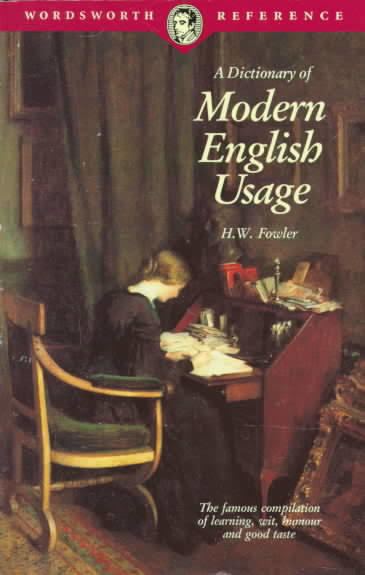8.4 /10 1 Votes8.4
OCLC 815620926 Genres Dictionary, Reference | 4.2/5 Goodreads Originally published 1926 Original language English Country United Kingdom | |||||||||||||||||||||||||||||||||
 | ||||||||||||||||||||||||||||||||||
Similar Works by Henry Watson Fowler, Dictionary books, English language books | ||||||||||||||||||||||||||||||||||
A Dictionary of Modern English Usage (1926), by Henry Watson Fowler (1858–1933), is a style guide to British English usage, pronunciation, and writing. Covering topics such as plurals and literary technique, distinctions among like words (homonyms and synonyms), and the use of foreign terms, the dictionary became the standard for other guides to writing in English. Hence, the 1926 first-edition remains in print, along with the 1965 second-edition, edited by Ernest Gowers, and reprinted in 1983 and 1987. The 1996 third-edition, re-titled as The New Fowler’s Modern English Usage (revised in 2004) was mostly rewritten by Robert W. Burchfield, as a usage dictionary that incorporated corpus linguistics data; and the 2015 fourth-edition, re-titled Fowler’s Dictionary of Modern English Usage, edited by Jeremy Butterfield, is like the third edition. Informally, users refer to the dictionary as Fowler’s Modern English Usage, Fowler, and Fowler’s.
Contents
Linguistic approach
In A Dictionary of Modern English Usage, Henry W. Fowler’s general approach encourages a direct, vigorous writing style, and opposes all artificiality, by firmly advising against convoluted sentence construction, the use of foreign words and phrases, and the use of archaisms. He opposed pedantry, and ridiculed artificial grammar rules unwarranted by natural English usage, such as bans on ending a sentence with a preposition; rules on the placement of the word only; and rules distinguishing between which and that. He classified and condemned every cliché, in the course of which he coined and popularised the terms battered ornament, Wardour Street, vogue words, and worn-out humour, while defending useful distinctions between words whose meanings were coalescing in practice, thereby guiding the speaker and the writer away from illogical sentence construction, and the misuse of words. In the entries "Pedantic Humour" and "Polysyllabic Humour" Fowler mocked the use of arcane words (archaisms) and the use of long words.
Quotations
Widely and often cited, A Dictionary of Modern English Usage is renowned for its witty passages, such as:
Editions
Before writing A Dictionary of Modern English Usage, Henry Fowler and his younger brother, Francis George Fowler (1871–1918), wrote and revised The King's English (1906), a grammar and usage guide later superseded by this book in the 1930s. Moreover, he researched the Dictionary assisted by Francis, who died in 1918 of tuberculosis, which he contracted in service with the British Expeditionary Force in the First World War (1914–1918). Fowler thus dedicated the Dictionary to his brother, Francis George:
I think of it as it should have been, with its prolixities docked, its dullnesses enlivened, its fads eliminated, its truths multiplied ... having been designed in consultation with him, it is the last fruit of a partnership that began in 1903 with our translation of Lucian.
The first edition of A Dictionary of Modern English Usage (1926) was much reprinted; thus, a reprint wherein the copyright page indicates 1954, as the most recent reprinting year, also notes that the 1930 and 1937 reprintings were "with corrections". The second edition, Fowler’s Modern English Usage (1965) was revised by Sir Ernest Gowers, who updated the text, contributed entries, and deleted articles "no longer relevant to [current] literary fashions". For the twenty-first century, the third edition, The New Fowler’s Modern English Usage (1996), was revised and published as Fowler’s Modern English Usage (2004), the editor of which, Robert Burchfield, in the preface acknowledges that, while "Fowler’s name remains on the title-page ... his book has been largely rewritten." A fourth edition, edited by Jeremy Butterfield, was published by Oxford University Press in 2015. The substantive and editorial differences between the first and third editions are that the former is a prescriptive style guide to clear and expressive writing, while the latter is a descriptive usage guide to spoken and written English. The 2009 reprinting of the 1926 first edition contains an introduction and commentary by the linguist David Crystal. The Pocket Fowler's Modern English Usage edited by Robert Allen was published by OUP in 1999. It was based mainly on Burchfield's 1996 edition, abridged to 40% by omitting about half the entries and reducing others; there was also some new content. A second edition of Allen's "Pocket Fowler" was published in 2008, which OUP said "harks back to the original 1926 edition".
